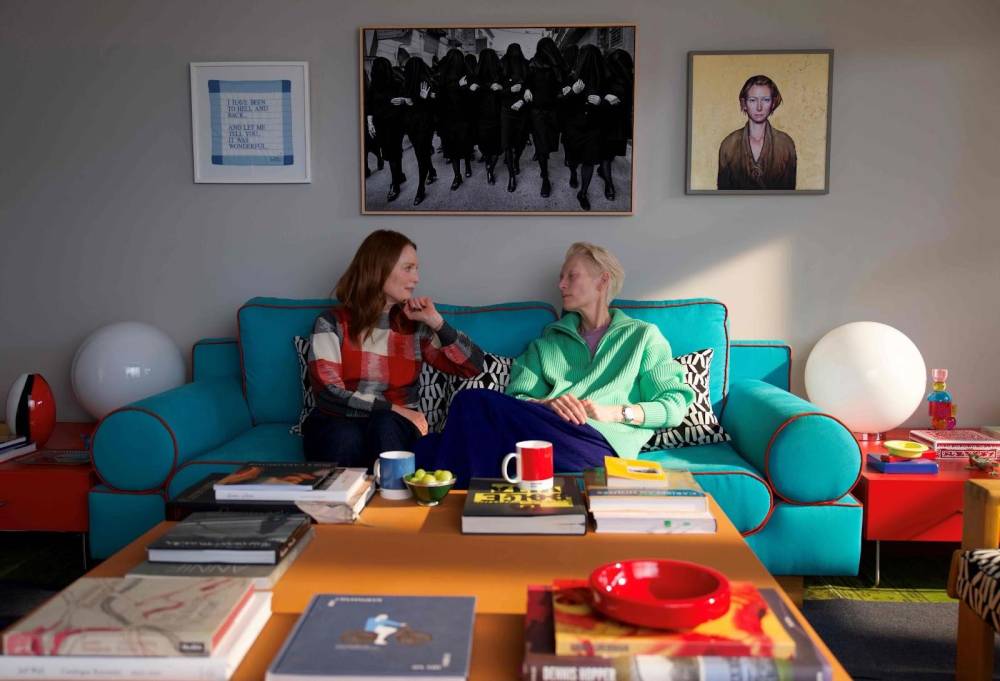Friends till the end in ‘The Room Next Door’

The acclaimed Spanish filmmaker Pedro Almodovar makes his first English-language feature-length movie with “The Room Next Door,” starring Tilda Swinton and Julianne Moore.
The film, which won the top prize (the Golden Lion) at last year’s Venice Film Festival, comes on the heels of two shorts that Almodovar did seemingly in preparation: “The Human Voice,” in which he first worked with Swinton; and “Strange Way of Life,” his second work in English that starred Ethan Hawke and Pedro Pascal, which he describes as a response to “Brokeback Mountain.”
An adaptation of Sigrid Nunez’s novel “What Are You Going Through,” in “The Room Next Door,” Swinton and Moore play two good friends who have been out of touch for a number of years, but reenter each other’s orbit on the occasion of a store signing for Ingrid’s (played by Moore) new book. Martha (Swinton) reveals to her friend that she has terminal cancer, and they regain their closeness during Ingrid’s visits to see Martha at the hospital. Eventually, Martha asks a favor: that Ingrid accompany her on a trip, upon which she will at some point end her own life.
A little off balance
Some portions of “The Room Next Door” can feel a little off balance. It’s not so much the pacing as the structure of the script, with flashbacks in the hospital sequences (as Martha tells Ingrid her life story, and explains why she is estranged from her daughter) that can feel out of place, even if they are beautifully shot. Every now and then, the fact that English is not Almodovar’s first language makes itself known as well, with some awkward phrasing or inelegant exchange.
Thankfully, the pros outweigh the cons. Alberto Iglesias’ score is beautiful and sweeping, and the vivid colors that are a staple of Almodovar’s aesthetic pop in the film (here aided by director of photography Eduard Grau, production designer Inbal Weinberg, and costume designer Bina Daigeler). The sets and locations, especially the house where Martha has chosen to end it, are gorgeous, candy to the eye.

What anchors everything, and gives the film its emotional heft, are the exemplary performances from the two leads, powerhouses in their own right, doing sensitive, careful work in their interactions, in their chemistry, and in their own individual scenes. Both actresses are icons, have been muses for other filmmakers, and their pairing here is so good it lends one to ask what took them so long to collaborate. It’s so obvious, so right. Almodovar knew it, and we get to enjoy the benefits.
Even if it can occasionally be clunky, and the content is weighty and deep, “The Room Next Door” is still a lovely meditation on the dignity of euthanasia, a love letter to friendship, and a moving rumination on mortality. Martha is not prone to regrets, though wishes she and her daughter were still in touch. Ingrid wonders what she would do in such circumstances.

John Turturro brings some nervous energy as an alarmist climate activist, pessimistic about the world’s future just as Martha and Ingrid strive to see what is worth living for.
There is a depth of feeling and emotion in “The Room Next Door” that satisfies what one would expect with this particular filmmaker, who’s always been inspired by powerful women, getting to work with these two particular women.
“The Room Next Door” plays exclusively at Ayala Malls Cinemas.





















